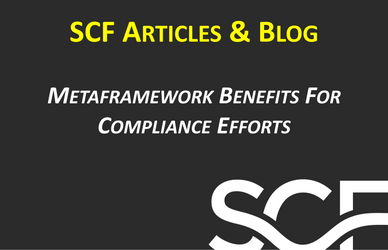Metaframework Benefits For Your Compliance Efforts
Posted by SCF Council on Jan 22nd 2024
A metaframework is a “framework of frameworks” and is useful for organizations that need to adhere to multiple laws, regulations and frameworks. The Secure Controls Framework (SCF) is a metaframework and offers numerous benefits for your compliance efforts by providing a structured and integrated approach to managing various cybersecurity and data privacy requirements.
Peter Sternkopf, President at Vigilant Systems, knows the benefits of leveraging a metaframework their clients’ complex compliance needs. As Peter states, “Vigilant Systems has been using the SCF since its inception and it has provided tremendous value to our clients. The SCF’s one-to-many controls relationship to standards, regulations, risks, threats, and vulnerabilities has helped manage our customers' complexities of multiple cybersecurity and privacy frameworks with one simple reference tool. Our clients love the SCF!” With several years of successful SCF implementation at multinational corporations, it is well-heeded advice.
Here are key advantages of incorporating the SCF as a cybersecurity & data protection metaframework into your compliance strategy:
- Integration of Multiple Standards: One of the primary advantages of a metaframework is its ability to integrate and align multiple cybersecurity & data protection standards and frameworks. Instead of managing compliance efforts in isolation, a metaframework allows you to consolidate and streamline your approach by incorporating requirements from various standards into a cohesive structure.
- Streamlined Compliance Management: Managing compliance with multiple standards can be complex and resource-intensive. A metaframework simplifies this process by providing a unified set of controls, requirements, and best practices. This streamlining enhances efficiency, reduces redundancy, and allows for a more effective allocation of resources.
- Holistic Risk Management: A metaframework enables a more holistic approach to risk management by considering the broader cybersecurity & data protection landscape. It allows organizations to identify, assess, and manage risks comprehensively, addressing potential vulnerabilities that may span across different standards and frameworks.
- Consistency in Implementation: With a metaframework, you can ensure consistency in the implementation of cybersecurity & data protection controls. This consistency is crucial for maintaining a strong security posture and for demonstrating adherence to various standards during compliance assessments.
- Efficient Auditing and Assessments: During audits or assessments, a metaframework facilitates a more streamlined and efficient process. Auditors can follow a structured and integrated approach, reducing the time and effort required to evaluate compliance with multiple standards. This can result in more effective audits and assessments.
- Resource Optimization: Resource optimization is a key benefit of using a metaframework. Instead of duplicating efforts across different compliance initiatives, organizations can optimize resources by focusing on a holistic set of controls and requirements. This is particularly valuable for organizations with limited resources.
- Adaptability to Changes: The cybersecurity & data protection landscape is dynamic, with standards and frameworks evolving over time. A metaframework provides adaptability to changes by offering a consolidated structure that can accommodate modifications in individual standards. This ensures that organizations can stay compliant even as standards and regulations evolve.
- Strategic Alignment: A metaframework allows organizations to align their cybersecurity & data protection efforts with broader strategic objectives. Instead of viewing compliance as a checkbox exercise, organizations can integrate cybersecurity practices into their overall business strategy, fostering a more proactive and strategic approach to security.
- Facilitation of Continuous Improvement: Continuous improvement is a fundamental principle in cybersecurity. A metaframework supports this by providing a framework that can be updated and refined to reflect changes in the threat landscape, technology, and regulatory environment. This ensures that cybersecurity & data protection practices remain effective and relevant over time.
- Enhanced Communication: A metaframework facilitates better communication across different stakeholders within an organization. It ensures that everyone is working towards a common set of cybersecurity goals and objectives, fostering a shared understanding of compliance requirements.
The bottom line is that a cybersecurity & data protection metaframework can greatly benefit your compliance efforts by providing a consolidated, efficient, and adaptable approach to managing the complexities of multiple cybersecurity standards and frameworks. It offers a strategic advantage in navigating the dynamic cybersecurity landscape and achieving a robust security posture.

